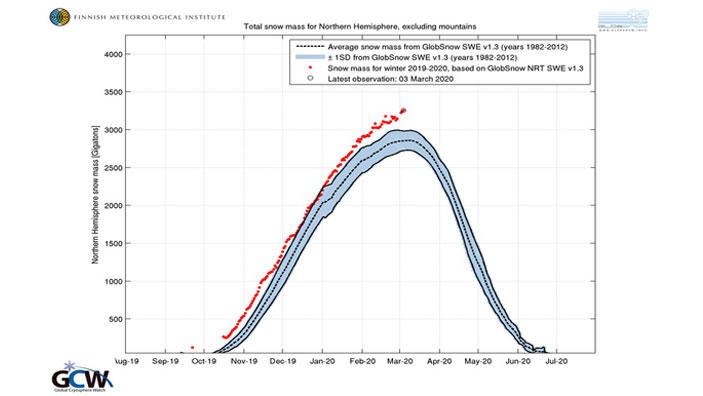German broadcaster RTL here reported how Northern Hemisphere snow mass has reached the highest level in years.

Image: Finnish Meteorological Institute
The Finnish Meteorological Institute (FMI) reports the total amount of snow in the northern hemisphere this winter season has been well above the long-term average from 1982 to 2012.
This will come as a surprise to Europeans, who have seen one of the mildest winters on record. According to RTL, “In those places where it was cold enough for snow at all, there was a lot of snow. The snow is meters high, higher than usual.”
Snow cover trending upwards since 1990
Looking at the northern Hemisphere snow cover charts from Rutgers University Global Snow Lab, northern hemisphere snow cover (area) has been on the rise since reaching a low in 1990.
Chart: Rutgers University Snow Lab.
Record-breaking snow across Montana and South Dakota
Meanwhile weather site Electroverse reports of “record breaking February snowfall” burying Montana and South Dakota. According to Electroverse, “The cold times are returning” due to reversing natural cycles.
https://electroverse.net/record-breaking-february-snowfall-buries-montana-and-south-dakota/?fbclid=IwAR1kAPeFTH5iQUy3dWglm0wk4aYHKDuS5HOUSbufD7Nh-_gXhEDoTnEA2hY






The USA western states are reported at the site below.
I don’t think these are extremely accurate because sites are often remote and automated. I’m in Washington State and irrigators are happy. Site reports both median and mean (average).
https://wcc.sc.egov.usda.gov/reports/UpdateReport.html?report=Western+US
[…] über Finnish Meteorological Institute Reports Northern Hemisphere Snow Mass “Highest Levels In Year”!… […]
Earth’s orbital eccentricity has been declining for about 10k years now. The decline in eccentricity has historically resulted in the onset of a period of glaciation in the Northern Hemisphere.
Those living in higher latitudes in the Northern Hemisphere should be concerned when the snow begins to accumulate causing the glaciers to expands. Slow snow melt from increasing snow mass results in greater solar reflection, which reduces total energy input to the NH. So snow accumulation results on a positive feedback that enhances cooling.
Rick – you can’t look just at eccentricity you also have to consider the Obliquity cycle changes in the inclination of the earth’s axis from 22.1 to 24.3 degrees and the Axial Precession.
This is a quote from a paper I have: The important thing to remember in terms of climatic change is that due to the length of the main cycle and the low eccentricity of the earth’s orbit, the eccentricity cycle results in an exceedingly small forcing. Or in other words the insolation changes due to eccentricity are very small by themselves. It is only through its effect on precession and obliquity that eccentricity becomes relevant.
From Nature Unbound I : The Glacial Cycle – judithcurry.com 2016/10/24 paper by Javier
[…] https://notrickszone.com/2020/03/08/finnish-meteorological-institute-reports-northern-hemisphere-sno… Finnish Meteorological Institute Reports Northern Hemisphere Snow Mass “Highest Levels In Year”! NoTricksZone: Not here to worship what i… / by P Gosselin / German broadcaster RTL here reportedhow Northern Hemisphere snow mass has reached the highest level in years. 16 weitere Wörter […]
[…] https://notrickszone.com/2020/03/08/finnish-meteorological-institute-reports-northern-hemisphere-sno… […]
[…] Finnish Meteorological Institute Reports Northern Hemisphere Snow Mass “Highest Levels In Year… […]